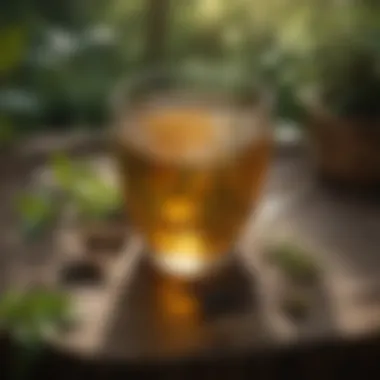Exploring Natural Sedatives for Anxiety Relief


Intro
The quest for natural solutions to anxiety remains a significant interest among both individuals and professionals. Traditional medications often present challenges such as side effects, dependency, and sometimes inadequate relief. As a consequence, many have turned to nature, seeking herbal and plant-derived sedatives that offer solace without the chemical complexities of pharmaceuticals. This article aims to explore the various natural sedatives, their effectiveness, and the science backing their use.
Understanding natural sedatives begins with recognizing their historical use in various cultures. Plants such as valerian root, chamomile, and passionflower have long been utilized in folk medicine as calming agents. Modern research is increasingly validating these practices, making it essential to analyze what the available evidence suggests about these remedies.
Another vital consideration is the role of healthcare professionals in this journey. It is imperative to consult with qualified practitioners before integrating these natural sedatives into one’s regimen. This ensures that individuals are aware of potential interactions with other medications and the risks associated with specific herbal treatments. Branishing complexity in psychological treatment, the available options should be carefully analyzed.
As we navigate through this article, we will highlight key substances, dive into their mechanisms of action, discuss relevant scientific studies, and ultimately present a resourceful guide for those interested in pursuing holistic anxiety relief.
Overview of Natural Sedatives
Natural sedatives can be categorized into various types, with some acting on the central nervous system and others promoting relaxation through different pathways. The effectiveness of these substances can vary based on individual circumstances, including the severity of anxiety and overall health conditions.
- Valerian Root: This herb is commonly used to combat insomnia and anxiety due to its calming effects. Studies indicate that it may enhance the quality of sleep while reducing symptoms of anxiety.
- Chamomile: Known for its gentle sedative properties, chamomile is frequently consumed as tea. Research suggests that it may provoke a significant reduction in anxiety symptoms and is often recommended for situational anxiety.
- Passionflower: This herb is another option that has been associated with decreased anxiety levels, particularly in individuals facing acute stress.
- Lavender: Often utilized in aromatherapy, lavender oil has demonstrated calming effects both in topical applications and as inhaled vapor, effectively lowering anxiety levels.
Each of these substances has its own unique profile, merits, and potential drawbacks. Understanding these factors is crucial for those seeking alternatives to conventional anxiety treatments.
"Natural remedies may offer a path to serenity distinct from pharmaceutical approaches, fostering a deeper connection with herbal traditions."
In the following sections of this article, we will analyze the specific mechanisms through which these natural sedatives operate, their supporting scientific research, and the advisability of utilizing them as part of a broader anxiety management strategy.
Prelims to Anxiety and Its Management
Anxiety is a pervasive issue affecting millions globally. Understanding how to manage it is vital for improving quality of life. This article aims to explore the concept of anxiety management comprehensively. It takes a special focus on natural sedatives as alternative methods. Such approaches may provide relief when traditional methods fall short.
The realm of anxiety disorders encompasses diverse conditions, each demanding unique management strategies. Identifying the underlying factors of anxiety plays a key role in adopting effective treatment options. Here, we will investigate both conventional and natural remedies. This exploration is crucial, as anxiety affects not just mental well-being but also physical health.
Understanding Anxiety Disorders
Anxiety disorders include a range of conditions characterized by excessive fear or worry. Common types include generalized anxiety disorder, panic disorder, and social anxiety disorder. Each has its own symptoms and specific management needs. Understanding these disorders can aid in recognizing the importance of addressing anxiety comprehensively.
Conventional Treatments for Anxiety
Conventional treatments often incorporate pharmaceutical options and therapeutic approaches. Both methods have their pros and cons. While they may effectively manage symptoms, some individuals prefer alternatives.
Pharmaceutical Options
Pharmaceutical options include selective serotonin reuptake inhibitors and benzodiazepines. These medications are popular due to their quick effectiveness in alleviating symptoms. They work by altering neurotransmitter levels in the brain, thus directly influencing mood and anxiety levels. However, potential side effects, such as dependency or withdrawal issues, raise concerns for some users. The reliance on pharmaceuticals can also create a stigma associated with mental health treatment.
Therapeutic Approaches
Therapeutic approaches involve various modalities such as cognitive behavioral therapy and mindfulness practices. These methods can be beneficial as they address the root causes of anxiety rather than just the symptoms. A key characteristic of therapy is its emphasis on personal growth and coping strategies. Individuals might find these approaches appealing because they promote long-term resilience. However, results can vary based on the individual's engagement and therapist's expertise.
"Understanding the multifaceted nature of anxiety leads to more tailored and effective treatment methods."
In summary, managing anxiety is a complex undertaking. By delving into both conventional and natural methods of treatment, we create a fuller picture. This article aspires to highlight options that may offer relief and improve overall mental health.
Natural Sedatives: An Overview
Natural sedatives for anxiety are becoming increasingly relevant in modern discussions about mental health. The quest for effective yet gentle solutions to anxiety has pushed individuals toward exploring options outside of conventional pharmaceuticals. Natural remedies, often derived from plants, offer potential relief without the side effects commonly associated with standard medications. This section clarifies the significance of understanding natural sedatives and the different factors individuals should consider when looking into these alternatives.
Definition and Historical Context


Natural sedatives are substances found in nature that can promote relaxation and ease anxiety. These may include herbal extracts, nutritional supplements, and essential oils. Historically, many cultures have relied on plant-based remedies for comfort and healing. For instance, chamomile has roots in ancient Egypt and is noted for its calming effects. The awareness and utilization of these natural substances span centuries. They often played a role in traditional medicine systems, such as Ayurveda and Traditional Chinese Medicine.
The growing interest in natural sedatives is also influenced by populations seeking more holistic and sustainable approaches to health. Today, this long-standing tradition meets contemporary needs as individuals seek alternatives in a world rife with rising stress levels.
The Appeal of Natural Remedies
The attraction to natural sedatives lies in their perceived efficacy and safety. Here are some key points that highlight their appeal:
- Organic Origins: Many natural sedatives are sourced from plants and herbs, making them appealing to those concerned about synthetic chemicals.
- Fewer Side Effects: Compared to traditional anti-anxiety medications, natural alternatives often have fewer and less severe side effects, making them accessible to a broader range of individuals.
- Cultural Acceptance: The acceptance of herbal and plant-based remedies in various cultures enhances their credibility and familiarity among users.
- Personal Control: Individuals may feel that choosing natural remedies gives them more control over their health decisions.
- Holistic Approach: Natural sedatives can fit into a holistic health regimen that focuses on overall well-being rather than just symptom management.
Despite these benefits, users should approach natural sedatives with discernment. Consulting healthcare professionals is crucial. Personal responsiveness to these remedies can vary significantly, emphasizing the importance of tailored approaches in mental health management. The exploration of natural sedatives requires careful consideration of both their potential benefits and possible limitations.
Common Natural Sedatives for Anxiety
In the search for effective anxiety management remedies, common natural sedatives play a significant role. These substances, primarily plant-based, have been praised for their calming properties and relatively low side effects compared to conventional medications. Understanding these options can empower individuals dealing with anxiety to make informed choices that align with their personal health needs. This section will delve into various natural sedatives categorized into herbal remedies, nutritional supplements, and essential oils, each offering unique benefits.
Herbal Remedies
Chamomile
Chamomile is known for its mild sedative effects, which can help in reducing anxiety and promoting relaxation. The key characteristic of chamomile is its ability to enhance sleep quality and lower tension. This herb can be consumed as a tea or in extract form, making it easy to include in a daily routine. A unique feature of chamomile is its safety profile; it is widely regarded as gentle and suitable for most individuals. However, those with allergies to plants in the daisy family should be cautious, as this may lead to adverse reactions.
Valerian Root
Valerian Root has a long history in traditional medicine for supporting sleep and reducing anxiety. Its key characteristic lies in its potential to increase gamma-aminobutyric acid (GABA) levels in the brain, which contributes to a calming effect. Many regard Valerian Root as a beneficial choice for nighttime anxiety relief. A notable feature is its effectiveness; many users report feeling more relaxed shortly after consumption. On the downside, it can cause drowsiness, so it is generally advised to avoid operating heavy machinery soon after use.
Passionflower
Passionflower is thought to act on serotonin receptors in the brain, contributing to its calming effects. It is celebrated for its ability to alleviate anxiety symptoms, making it a popular choice among those seeking herbal solutions. This sedative is typically taken in tincture or tea form. The unique feature of Passionflower is its versatility, as it can be combined with other herbs like chamomile for enhanced effects. However, some individuals might experience dizziness or confusion after taking it, which necessitates caution when first trying it.
Nutritional Supplements
L-Theanine
L-Theanine is an amino acid commonly found in green tea. It is known for its ability to promote relaxation without drowsiness. This compound is particularly beneficial for individuals looking to reduce anxiety in high-stress situations without compromising alertness. The unique feature of L-Theanine is its capacity to increase alpha brain wave activity, which is associated with a calm but alert state. Some users note that excessive intake could lead to mild gastrointestinal discomfort, so moderation is key.
Magnesium
Magnesium plays a crucial role in brain function and emotional well-being. It is often cited for its ability to help regulate neurotransmitters, which influence mood. This mineral is an important addition for anyone dealing with anxiety, as it can enhance relaxation. Magnesium supplements can come in various forms, with citrate and glycinate being commonly recommended for their bioavailability. A key consideration is that while low magnesium levels can exacerbate anxiety, excessive supplementation may lead to diarrhea. Keeping a balanced intake is essential.
Omega-3 Fatty Acids
Omega-3 Fatty Acids, particularly EPA and DHA, have been studied for their positive effects on mental health. These fatty acids can influence inflammation and neurotransmission, both of which are significant in anxiety disorders. A beneficial aspect of Omega-3s is their wide availability through dietary sources like fish and flaxseed, along with supplementation options. However, some may experience gastrointestinal upset with larger doses, so gradual introduction is recommended to gauge tolerance.
Essential Oils
Lavender Oil
Lavender Oil is widely recognized for its soothing aroma and therapeutic benefits. It has been shown to reduce anxiety and improve sleep quality. This essential oil can be utilized in aromatherapy, topical applications, or even added to bath water for relaxation. A prominent feature of lavender is its extensive research backing its effectiveness. While generally safe, individuals with allergies or sensitivities to lavender should approach its use with caution.
Bergamot Oil
Bergamot Oil is extracted from the peel of the bergamot orange and is prized for its uplifting yet calming effects. It can help in alleviating stress and anxiety through aromatherapy or topical use. A unique element of bergamot is its dual ability to promote feelings of calm while also enhancing mood. However, it is important to note that bergamot can increase skin sensitivity to sunlight, so precautions should be taken if applied topically.
Ylang-Ylang Oil


Ylang-Ylang Oil is celebrated for its sweet floral scent and is used for its ability to reduce stress and promote relaxation. This oil can be diffused or used in massage for its calming benefits. Its distinctive characteristic is its role in lowering heart rate and improving mood. However, larger doses may lead to headaches or nausea, warranting a cautious approach to its use.
Understanding these natural sedatives, their benefits, and potential drawbacks is vital for anyone considering them as part of their anxiety management strategy. Consulting with healthcare professionals prior to incorporating these options into a regimen ensures a safe and informed approach.
Mechanisms of Action
Understanding the mechanisms of action for natural sedatives provides insight into how these substances affect the body in the context of anxiety management. Different compounds interact with various biological systems, influencing mood and stress levels. This section highlights the biological pathways involved and their significance in the overall effectiveness of natural sedatives. Knowing these mechanisms helps individuals make informed choices about incorporating them into their anxiety treatment plans.
Biological Pathways Involved
Neurotransmitter Regulation
Neurotransmitter regulation is a crucial aspect of how natural sedatives work. The body utilizes neurotransmitters like serotonin, dopamine, and gamma-aminobutyric acid (GABA) to manage mood and anxiety levels.
Natural sedatives can enhance the body’s production, release, or uptake of these neurotransmitters. For example, compounds from Chamomile may increase GABA levels, producing a calming effect. This property is attractive because it aligns with the body’s existing systems. A key characteristic of neurotransmitter regulation is its ability to create balance without the harsh side effects often associated with pharmaceutical solutions.
The unique feature of this action is that it supports mental health naturally. Instead of artificially manipulating mood, these substances often restore normal function, promoting overall well-being. However, one disadvantage is variability in individual responsiveness—what works for one person may not work for another.
Stress Response Modulation
Stress response modulation refers to how natural sedatives impact the body’s reaction to stress. This response is primarily managed through the hypothalamic-pituitary-adrenal (HPA) axis. Natural sedatives can influence this axis, thereby reducing the production of stress hormones like cortisol.
This modulation means that individuals may experience a decreased perception of stress when using these remedies. A key characteristic of stress response modulation is its ability to lower physiological markers of anxiety, offering a calming sensation with fewer side effects. It is noted as a powerful ally against chronic stress, making it a popular choice among those looking for alternatives to conventional treatments.
The unique feature of this mechanism is that it not only calms but also improves resilience to future stress. However, a potential disadvantage includes the necessity for consistent use to maintain this balance, as stopping suddenly may cause rebound effects.
Impact on the Nervous System
The impact on the nervous system is fundamental in the overall approach to anxiety relief. Natural sedatives often target areas of the brain linked to stress responses, providing a more holistic approach to mental health. Their action can lead to improvement in sleep quality, emotional regulation, and overall stress levels. Maintaining nerve health is essential for long-term well-being.
Research and Evidence
Research into natural sedatives for anxiety remains a crucial aspect of understanding their effectiveness and safety profile. As individuals become more inclined toward holistic approaches for anxiety management, empirical evidence provides a solid foundation for guiding choices. It is important to assess both individual studies and overarching trends that emerge from comprehensive reviews in this field. Meta-analyses play a significant role, synthesizing data from various studies to offer clearer conclusions on the efficacy of certain natural remedies versus placebo or conventional treatments.
Evaluating research and evidence involves several critical elements. First, it helps ascertain what dosage and form of these sedatives yield the best outcomes. Second, it highlights any potential adverse effects, which are essential for informed decision-making. Lastly, studies can reveal synergies or competing interactions with other commonly prescribed medications. Hence, deep dives into this body of literature are necessary, as they show real-world applications and theoretical frameworks supporting the integration of natural sedatives in treatment plans.
Clinical Studies on Herbal Sedatives
Multiple clinical trials have focused on specific herbal sedatives, providing insight into their real-world impacts on anxiety. For instance, studies on chamomile have shown significant reductions in anxiety levels among participants. A notable study published in Journal of Clinical Psychopharmacology found that chamomile extract, taken over a period of eight weeks, reduced anxiety scores when compared to a placebo group. Other herbs like valerian root and passionflower have also been subjects of clinical research. Their use in managing insomnia and anxiety symptoms indicates a promising avenue for those seeking alternatives to pharmaceuticals.
The results of these studies often hinge on controlled environments that ensure reliability and validity. Participants are generally screened for various factors, including existing health conditions and current medication use, to keep the findings focused. However, while these studies are promising, they often call for larger and more diverse samples to truly understand how these herbal sedatives can be variably effective within wider populations.
Meta-Analyses and Reviews
Meta-analyses and systematic reviews serve as instrumental tools in consolidating diverse research findings on herbal sedatives. These comprehensive assessments gather data from numerous clinical studies, allowing for a broader analysis of effectiveness and safety. For example, a meta-analysis published in Frontiers in Pharmacology evaluated several herbal sedatives and concluded that certain compounds consistently showed anxiety-reducing properties with minimal risk of side effects.
The systematic approach taken in meta-analyses helps to eliminate biases often found in individual studies. By drawing a larger pool of data, these reviews can dissect factors such as dosage, duration of treatment, and specific populations to understand variability in outcomes better.
Moreover, they highlight gaps in existing research, suggesting areas for further exploration. For example, while chamomile and valerian root have strong evidence supporting their use, less research exists for others, like kava or lemon balm. This knowledge can guide future studies and inform healthcare professionals' recommendations, ensuring patients receive well-rounded advice regarding their anxiety management strategies.
Risks and Considerations
When exploring natural sedatives, it is essential to consider the risks and benefits associated with their use. While many individuals seek out these alternatives in search of relief from anxiety, it is important to understand that such remedies are not without their complications. Engaging in a detailed evaluation of natural sedatives requires awareness of potential side effects and interactions with other medications. This section elucidates why a cautious approach is critical.
Potential Side Effects


Natural sedatives are often perceived as safer alternatives to pharmaceutical options. However, that perception does not eliminate the possibility of side effects. Commonly reported side effects can range from mild to severe and may vary depending on the specific sedative.
- Chamomile can cause drowsiness, nausea, or allergic reactions in some users.
- Valerian root may lead to headaches, dizziness, and stomach upset.
- Passionflower is known to cause side effects like dizziness and confusion in some instances.
Understanding these side effects is key for users. It can help identify any adverse responses that may occur, allowing for safer consumption of these natural remedies. Always consider starting with small doses to monitor for side effects.
Research indicates that while side effects are often mild, they can still impact daily life. Therefore, educate yourself about the specific natural sedative you plan to use, examining evidence-based outcomes in studies and reviews.
Interactions with Other Medications
Integrating natural sedatives into a treatment regimen demands scrutiny regarding possible interactions with other medications. Many people often do not recognize that just because a remedy is natural, it does not mean it is free from complications.
Notably, certain herbal remedies can interact negatively with prescription medications. For instance:
- L-Theanine might enhance the effects of benzodiazepines, leading to increased sedation.
- Magnesium can aggravate side effects when used in conjunction with certain diuretics or muscle relaxants.
- Lavender oil has been shown to interact with drugs that affect the central nervous system, amplifying effects.
Consequently, consulting healthcare professionals is paramount before adding any natural sedative to a treatment plan, particularly if the individual takes multiple prescriptions.
"The marriage of natural remedies and conventional medicine should be approached with prudence to ensure safety and effectiveness."
Overall, weighing the benefits against potential risks is crucial. Knowledge about side effects and drug interactions can empower individuals to make informed choices about using natural sedatives in managing anxiety. Always prioritize open communication with healthcare providers to mitigate any risks involved.
Integrating Natural Sedatives into Treatment Plans
Integrating natural sedatives into treatment plans requires a careful approach. It is essential to recognize that while these remedies can offer relief, they should not replace conventional treatments without proper guidance. The importance of this integration lies in the potential enhancement of overall well-being. Natural sedatives can complement existing therapeutic strategies, leading to a more holistic approach to anxiety management.
Before incorporating any natural sedative, individuals should evaluate their personal health conditions. An understanding of how these natural options work, along with being cognizant of any underlying medical issues, plays a vital role. It is also crucial to consider individual responses to these sedatives, as effects can vary significantly from person to person.
Incorporating natural sedatives can yield multiple benefits. These benefits can include:
- Reduced anxiety symptoms: Many natural sedatives target aspects of anxiety directly, providing soothing effects.
- Fewer side effects: Compared to some pharmaceuticals, natural remedies often come with milder side effects, although they are not without risk.
- Holistic benefits: Some natural sedatives promote better sleep, which is frequently disrupted by anxiety and can amplify its effects.
When considering natural sedatives, a well-rounded treatment plan is indispensable.
Thus, the experience of healthcare professionals is invaluable in this process. They provide tailored advice that respects individual health profiles and goals. Only by considering all aspects can a person develop a beneficial and sustainable approach to anxiety relief.
Consulting Health Professionals
The guidance of health professionals is paramount when integrating natural sedatives into a treatment plan. Specialists, including physicians or registered dietitians, can assess individual circumstances to determine compatibility with existing treatments. This assessment can help in identifying any risks associated with certain natural ingredients.
Healthcare professionals can also educate patients regarding potential interactions. For instance, some herbal remedies might affect the efficacy of prescribed medications for anxiety or other conditions. Secure consultation equips individuals with the knowledge needed to navigate these complexities, ensuring that the integration is not only safe but also effective.
Mindfulness and Lifestyle Changes
Incorporating mindfulness and lifestyle changes complements the use of natural sedatives effectively. Mindfulness practices, such as meditation or yoga, can enhance the calming effects of these remedies. Engaging in such activities can foster a better understanding of one’s anxiety triggers and responses.
Moreover, lifestyle factors like diet, exercise, and sleep hygiene are essential in managing anxiety. A balanced diet rich in nutrients, regular physical activity, and adequate sleep can create a foundation for resilience against stress. This foundation is supportive to the use of natural sedatives in the pursuit of anxiety relief. It aids in reinforcing the body's natural calmness, making sedatives even more effective.
Through mindful integration of both natural remedies and lifestyle alterations, individuals can achieve a more thorough approach to managing their anxiety. This dual strategy maximizes potential benefits, leading to a sustainable and balanced path toward better mental health.
Ending
The discussion surrounding natural sedatives for anxiety is essential in the context of modern health practices. These alternatives to conventional treatments can offer a more holistic approach that appeals to individuals seeking calmness without the side effects of pharmaceutical drugs.
Future Research Directions
Future research must focus on the effectiveness of various natural sedatives in controlled environments. Exploring large-scale clinical trials that encompass diverse populations can clarify which products yield the best results. Studies examining the long-term effects of these natural remedies should also be prioritized. This will provide a clearer understanding of their safety and efficacy, unveiling potential new methods for managing anxiety.
Final Thoughts on Natural Sedatives
Natural sedatives provide an intriguing perspective on anxiety management. Their historical use and increasing popularity suggest a willingness among the public to explore holistic methods. The risks and potential interactions are significant considerations that must not be overlooked. While integrating these remedies into treatment remains a personal choice, governed by individual circumstances, the importance of consulting health professionals cannot be overstated. Their expert guidance can help navigate this complex landscape, leading to safe and effective anxiety relief.













